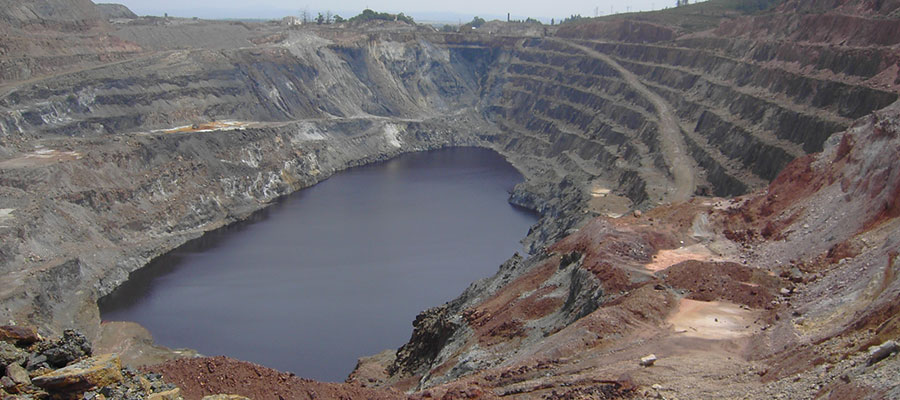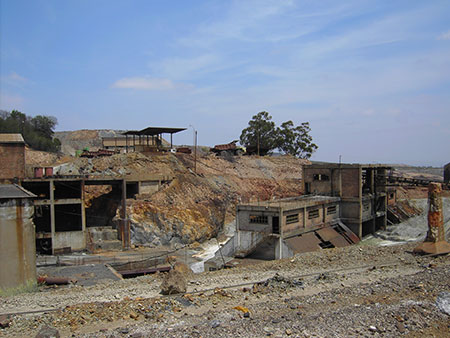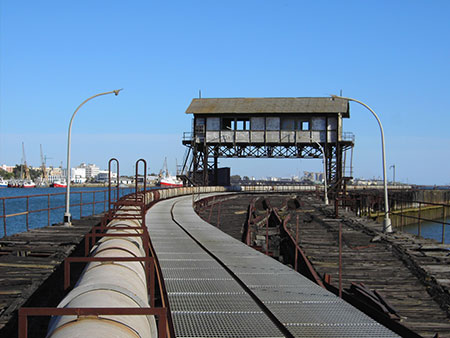
I waited as the sun burned through an early morning mist to gradually uncover the abandoned Tharsis mine - a desolate and mysterious place. In the uncanny stillness it was difficult to imagine that it was once the most profitable copper mine in the world and that it had, along with the Rio Tinto mine, dominated the Province of Huelva's economy.
Workers had once swarmed over the enormous open-cast excavations and sweated in the decaying labyrinthine system of tunnels and shafts. Amid the noise, bustle, clank of machinery and roar of engines, heaps of ore roasted in the open-air had released great floating and poisonous sulphurous clouds that destroyed vegetation, corroded metal fittings and attacked lungs.
 Now there is silence. A green mantle covers the once widely disfigured landscape but the scars left behind are dramatic and strangely beautiful. Huge open pits expose inners of greens, blues, greys, browns and reds. And the craters, with their darkly polluted waters, are streaked in a myriad of wonderfully startling patterns.
Now there is silence. A green mantle covers the once widely disfigured landscape but the scars left behind are dramatic and strangely beautiful. Huge open pits expose inners of greens, blues, greys, browns and reds. And the craters, with their darkly polluted waters, are streaked in a myriad of wonderfully startling patterns.
Not worked since Roman times, a French company made a failed attempt to exploit the mines at Tharsis and La Zarza in the 1850s. They were then taken over by The Tharsis Sulphur and Copper Company Limited in 1866. Incorporated in Edinburgh in the same year, and with its head office in Glasgow, a Scot, Charles Tennant (later Sir Charles), was the company's principle founder and first chairman. Representative of the visionary entrepreneurship of a Victorian Britain at the zenith of its imperial, industrial and economic power, he successfully headed the Tharsis Company in its risky venture by a skilful combination of capital, railway construction and commercial courage.
Packhorses, mules and carts were replaced by around 50 kilometres of railway connecting Tharsis with Corrales where a new pier with modern docking facilities greatly reduced turn about time of costly ore-carrying steam ships. By 1871 Tharsis and Corrales were linked by electric telegraph. When the principle mining effort was transferred to La Zarza in 1888, a further 30-odd kilometres of railway was constructed, joining it to Tharsis and Corrales.
Wasteful small scale and underground working was superseded by open-cast mining. This also simplified supervision and labour costs and eased recruitment by greatly reducing the need for traditional mining skills. Exploited primarily for its sulphur and copper content, gold, silver and the iron residue were also extracted from the mined ore and added to the company's profitability.
 Two new communities at the Tharsis and La Zarza mines and a smaller settlement at the railway terminal and pier in Corrales were created with a total population of about 8000 men, women and children. The 50 or so British managers, mostly Scots raised in the self-help Presbyterian tradition, enforced strict discipline and represented a culture that was alien to that of the traditional, catholic and largely illiterate workforce. A colonial style segregation and paternalism intensified the company's difficulties in an increasingly volatile environment.
Two new communities at the Tharsis and La Zarza mines and a smaller settlement at the railway terminal and pier in Corrales were created with a total population of about 8000 men, women and children. The 50 or so British managers, mostly Scots raised in the self-help Presbyterian tradition, enforced strict discipline and represented a culture that was alien to that of the traditional, catholic and largely illiterate workforce. A colonial style segregation and paternalism intensified the company's difficulties in an increasingly volatile environment.
When the Tharsis mine showed signs of copper exhaustion in the 1890s it was decided to invest heavily in modernising and developing the Tharsis and La Zarza lodes for sulphur extraction only rather than close them or seek new mining opportunities. But in the 1900s there were two market-disrupting world wars, a major inter-war depression, worker militancy and strikes, the Spanish Civil War with its nationalism and political instability, fluctuating sulphur markets, the rise of new and competitive sulphur sources, and the consolidation in Spain of a system of economic control.
In the 1960s Spanish sensitivity to economic exploitation by foreign interests added to the company's uncertainties. It was subsequently sold to Campañia Española de Minas de Tharsis SAL, a Spanish company, and later passed to Nueva Tharsis SAL, a labour company created in 1996. It soon ceased production.
Wandering through the derelict buildings and deserted rail terminal is an eerie experience. As though hastily abandoned in the face of sudden catastrophe, documents lie on desks or are scattered over floors, stained brown by rain seeping through rotting roofs. Hoppers, silently rusting away, still wait for the loads of ore on conveyer belts now frozen into ghostly stillness. And British-built locomotives, and massive 'Terex' haulers with wheels twice as tall as a man, slowly disintegrate under Andalucia's harsh summer sun and cold winter rain.
In the nearby village cemetery is a simple and much-weathered memorial. In barely decipherable words it reads 'Lawrence Gould Down died at Tharsis mines 22 November 1878 age 29 years'. It was the only British grave I could find.
 Stretches of the company's railway track between the mines and Corrales remain intact. In Corrales the pier is in a dangerous state of collapse. Its junction box/control tower still stands but it is dilapidated and inaccessible. Of the terminal with its railway tracks, yards, workshops, garage, stores, crushing plants and civil guards' barracks, only a crumbling building with its chimneystack and the railway station survive.
Stretches of the company's railway track between the mines and Corrales remain intact. In Corrales the pier is in a dangerous state of collapse. Its junction box/control tower still stands but it is dilapidated and inaccessible. Of the terminal with its railway tracks, yards, workshops, garage, stores, crushing plants and civil guards' barracks, only a crumbling building with its chimneystack and the railway station survive.
But the 1920s station has been carefully restored. And the beautifully reinstated and again functioning 'Teatro Cinema Corrales', originally opened in 1954 by H P Rutherford II, a Scot and the then Tharsis managing director and chairman, is a reminder of the company's British connection. So also is the Casino Minero de Corrales, built in 1918 as a cultural and recreation centre and located in Plaza Rutherford.
However, this may not be the end of the Tharsis story. In a joint venture with Nueva Tharsis SAL in 1997, the Irish company Ormonde Mining plc evaluated unexplored copper, gold and silver resources at La Zarza mine and in 2004 commenced preliminary drilling with the objective of establishing the viability of future mining operations.